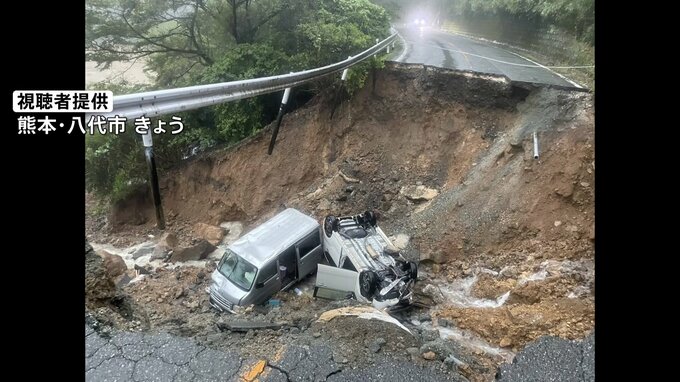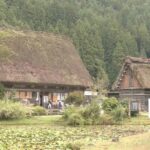Record-breaking heavy rain has been falling since last night, leading to the Disaster Relief Act being applied to 10 cities and towns in Kumamoto Prefecture.
“Oh no, it collapsed!”
“This is scary!”
Nagasaki Prefecture experienced heavy rain with thunderstorms since last night. In areas like Nagasaki City, where linear precipitation bands formed, rainfall since the 8th has exceeded 300 mm, setting a new record.
“The rain is coming down sideways, and occasional thunder can be heard.”
Linear precipitation bands also occurred in Oita Prefecture. Hita City recorded its highest hourly rainfall in history at 117 mm.
“The road is flooded, and cars are submerged.”
Kumamoto Prefecture also saw linear precipitation bands. At Kumamoto Castle Hall, rainwater cascaded down the stairs. The heavy rain has caused road closures and widespread damage.
“This is Mashiki Town in Kumamoto Prefecture. What looks like a river here was originally all rice fields. Multiple fields have merged into one.”
Mashiki Town recorded its highest 24-hour rainfall in history at 354 mm. The heavy rain flooded rice fields, and…
“This road ahead is now impassable.”
In Yatsushiro City, intense rain caused roads to flood, with water levels reaching about 60 cm. Cars noticing the rising water began turning back.
Matsuhama-ken, a nationally designated scenic spot and tourist attraction, was also flooded.
The largest shopping arcade in Kumamoto Prefecture was submerged, forcing people to tiptoe to avoid wetting their shoes. One woman wore sandals while carrying her previous footwear.
“I borrowed these sandals. My car won’t move—it’s completely flooded.”
This footage from around 8:30 AM shows the Kagami River in Yatsushiro City, where water levels nearly overflowed the banks.
Around 9:00 AM, the Midori River in Kosai Town, normally calm, had risen significantly.
By 9:30 AM, the Machiyamaguchi River in Amakusa City overflowed into residential areas.
Damage has been reported across multiple locations.
“It’s coming down—dangerous!”
Footage from a car in Uto City, Kumamoto Prefecture, shows…
“Whoa, whoa—dangerous!”
Mudslides rapidly flowing alongside the moving vehicle.
“It was terrifying. Just as we hesitated whether to proceed, mud kept pouring uncontrollably from above.”
The person recording turned back, but the retreating path was also flooded.
In Yatsushiro City, two cars fell into a road collapse caused by the rain, with both drivers hospitalized.
In Kosai Town, a family of four was caught in a landslide. A mother and two children were rescued by firefighters, while a man was later found in cardiac arrest.
Authorities are urgently identifying the man, who may be the missing father.
Due to the extensive damage, the Disaster Relief Act has been enacted for 10 municipalities in Kumamoto Prefecture.
Kumamoto Castle Hall
Kumamoto Castle Hall is a modern event and exhibition venue located near the historic Kumamoto Castle in Kumamoto, Japan. While the hall itself is a contemporary facility, it serves as a cultural hub that complements the nearby 17th-century castle, which was built by the feudal lord Kato Kiyomasa and is a significant historical landmark. The hall hosts various cultural events, promoting local arts and heritage in connection with the castle’s rich samurai history.
Mashiki Town
Mashiki Town is a municipality located in Kumamoto Prefecture, Japan, known for its agricultural production, particularly watermelons and tomatoes. The town gained international attention in April 2016 when it was severely affected by the Kumamoto earthquakes, which caused significant damage to buildings and infrastructure. Despite the disaster, Mashiki has been working on recovery efforts while preserving its rural charm and community spirit.
Yatsushiro City
Yatsushiro City, located in Kumamoto Prefecture, Japan, is a historic city known for its cultural heritage and scenic beauty. It flourished as a castle town under the rule of the Kato and Matsui clans during the Edo period (1603-1868) and is home to landmarks like the ruins of Yatsushiro Castle. Today, the city is also famous for its traditional crafts, such as Yatsushiro ware pottery, and its vibrant festivals, including the Yatsushiro Myoken Festival.
Matsuhama-ken
There is no widely recognized cultural or historical site known as “Matsuhama-ken” in Japan. It may be a misspelling or a lesser-known local place. If you meant a specific location, such as Matsushima (a famous scenic bay in Miyagi Prefecture) or another site, please provide more details for an accurate summary.
Kagami River
The Kagami River (鏡川), located in Kochi Prefecture, Japan, is a scenic river known for its clear waters and natural beauty. Historically, it has been an important water source for agriculture and daily life in the region. The river’s name, meaning “Mirror River,” reflects its calm surface, which often mirrors the surrounding landscapes and seasonal changes.
Midori River
The Midori River (緑川), located in Kumamoto Prefecture, Japan, is a scenic river known for its clear waters and lush surroundings. Historically, it played a vital role in regional agriculture and transportation, with its basin supporting rice paddies and local communities for centuries. Today, it is a popular spot for leisure activities like fishing and riverside walks, blending natural beauty with cultural significance.
Machiyamaguchi River
The Machiyamaguchi River is a scenic waterway in Japan, known for its natural beauty and tranquil surroundings. Historically, it has played a role in local agriculture and transportation, with some areas preserving traditional landscapes. Today, it is a peaceful spot for walking, nature appreciation, and cultural reflection.
Uto City
Uto City, located in Kumamoto Prefecture, Japan, is known for its historical significance and natural beauty. It is home to the famous Uto Shrine, which dates back over 1,300 years and is dedicated to the legendary prince Yamato Takeru. The city also offers scenic views of Mount Uto and is a gateway to the nearby Aso-Kuju National Park.






